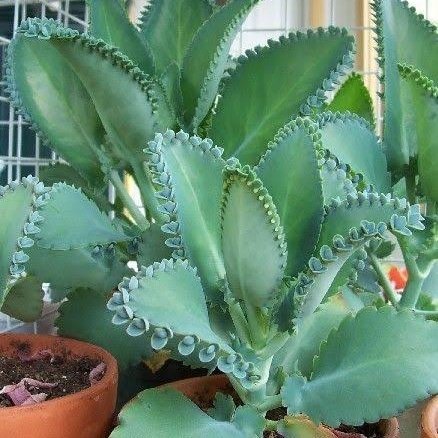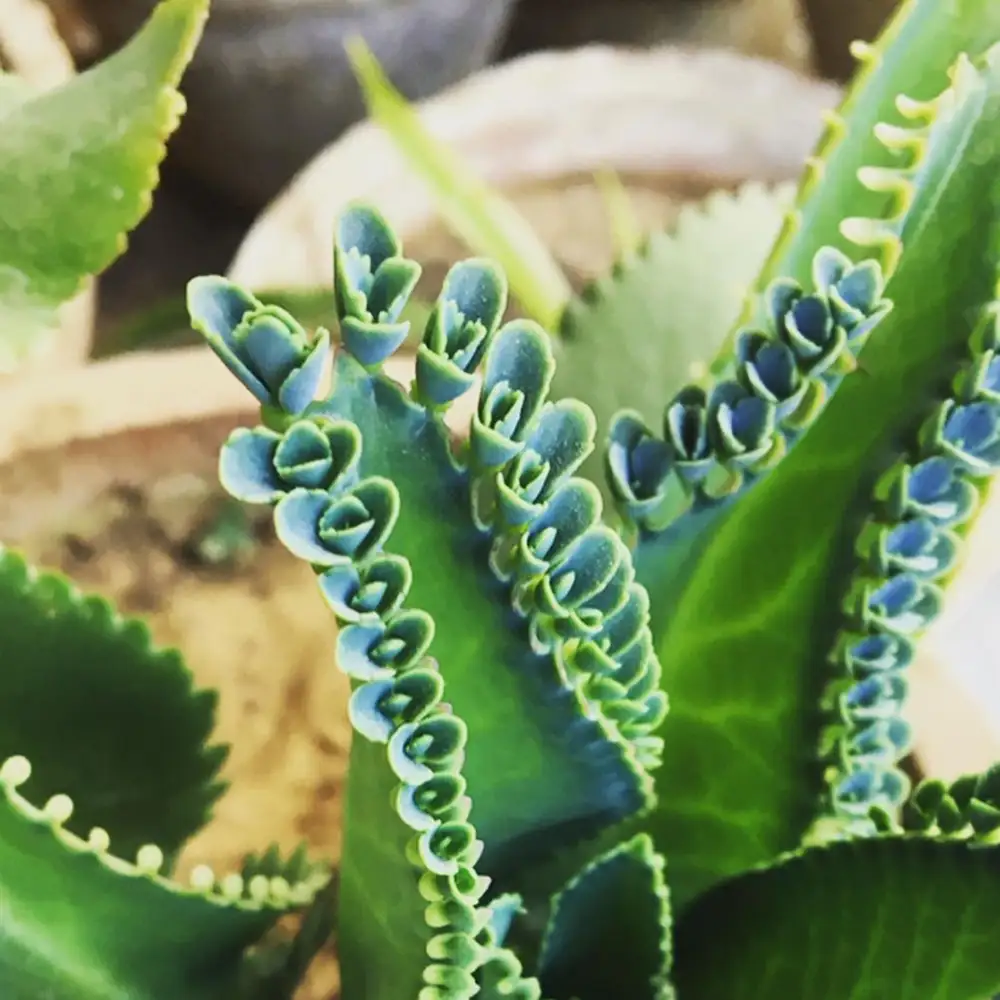Introduction to the Mother of Thousands
Mother of Thousands, scientifically known as Kalanchoe daigremontiana, is a succulent plant that captivates plant enthusiasts with its unique propagation method and striking appearance. This plant, native to Madagascar, has earned its common name due to its prolific production of tiny plantlets along the edges of its leaves. These baby plants can grow into new, independent plants, making the Mother of Thousands a true marvel of nature.
The allure of the Mother of Thousands isn’t just in its unusual reproductive strategy. It’s a plant that’s relatively easy to care for, making it a favorite among both novice and experienced gardeners. Its thick, fleshy leaves are adorned with serrated edges, from which the miniature plantlets sprout. These plantlets eventually drop off, taking root wherever they land, and thus, the cycle of life continues.
Appearance and Unique Features
The Mother of Thousands is visually striking, with its long, green to bluish-green leaves that grow in opposite pairs along the stem. Each leaf can reach up to 6 inches in length and is lined with tiny plantlets, also known as bulbils or offsets. These bulbils are what set this plant apart from many other succulents. They look like tiny versions of the adult plant and are capable of growing into full-sized plants themselves.
The plant’s leaves are somewhat curved and have a distinctive pattern of dark spots on the underside. These spots are actually part of the plant’s unique way of reproducing. The bulbils develop from these spots and mature into little plants ready to detach and grow independently. This vegetative reproduction allows the Mother of Thousands to spread quickly, which can be both a blessing and a curse for gardeners.
One of the most fascinating aspects of the Mother of Thousands is its resilience. It can thrive in a variety of conditions, from full sunlight to partial shade, and it is relatively drought-tolerant. This makes it an ideal houseplant for those who might not have the greenest of thumbs. However, it’s essential to note that the plant can become invasive if not managed properly, especially in warmer climates where it can grow year-round outdoors.
Care and Maintenance
Caring for a Mother of Thousands is straightforward, making it a perfect plant for those new to gardening. The primary requirements are well-draining soil, adequate sunlight, and occasional watering. Here’s a more detailed look at how to keep your Mother of Thousands thriving:
Light
The Mother of Thousands prefers bright, indirect sunlight but can tolerate some direct sun. Placing it near a sunny window where it can receive plenty of light will help it grow strong and healthy. However, too much direct sunlight, especially during the hottest part of the day, can cause the leaves to scorch. If you notice browning or sunburn spots on the leaves, it might be a sign that the plant needs a little less direct exposure.
Watering
Watering is crucial for the health of your Mother of Thousands. Like most succulents, it is susceptible to root rot if overwatered. The best practice is to allow the soil to dry out completely between waterings. When you do water, make sure to soak the soil thoroughly, allowing excess water to drain away. During the winter months, the plant’s growth slows down, and it will require even less water. Always err on the side of underwatering rather than overwatering.
Soil
A well-draining soil mix is essential for the Mother of Thousands. A cactus or succulent mix available at most garden centers will work well. You can also create your own mix by combining regular potting soil with sand or perlite to improve drainage. This prevents the roots from sitting in water, which can lead to root rot and other issues.
Propagation: The Endless Cycle
Propagation is where the Mother of Thousands truly shines. Unlike many other plants that require seeds or cuttings for propagation, this plant does the work for you. The tiny plantlets along the edges of the leaves are ready to drop and take root with minimal effort.
Natural Propagation

The easiest way to propagate the Mother of Thousands is to let nature take its course. The plantlets will eventually drop from the parent plant and land in the surrounding soil. As long as the conditions are right, these plantlets will take root and begin to grow. This can result in a dense mat of plants if not managed, so you may need to thin them out periodically to prevent overcrowding.
Controlled Propagation
For a more controlled approach, you can gently remove the plantlets from the parent plant and place them on top of a well-draining soil mix. Lightly press them into the soil and mist them with water to help them settle in. Keep the soil slightly moist until the plantlets establish roots, which typically takes a few weeks. Once they have rooted, you can treat them like mature plants, watering them less frequently.
Common Problems and Solutions
Even though the Mother of Thousands is relatively easy to care for, it can encounter a few common issues. Knowing how to address these problems can help you maintain a healthy, thriving plant.
Pests
Aphids and mealybugs are the most common pests that might bother your Mother of Thousands. These pests can be controlled with insecticidal soap or neem oil. Regularly inspecting your plant for signs of pests will help you catch and treat infestations early before they become a significant problem.
Overwatering
As mentioned earlier, overwatering can be detrimental to the health of your Mother of Thousands. Signs of overwatering include yellowing leaves, mushy stems, and root rot. If you suspect overwatering, reduce the frequency of watering and ensure that your plant is in well-draining soil. In severe cases, you might need to repot the plant, removing any rotten roots and placing it in fresh soil.
Leggy Growth
If your Mother of Thousands is not receiving enough light, it may become leggy, with long, stretched-out stems and sparse leaves. To remedy this, move the plant to a brighter location where it can receive more indirect sunlight. In some cases, you might need to prune the plant back to encourage more compact, bushy growth.
Toxicity and Safety
While the Mother of Thousands is a fascinating and beautiful plant, it’s important to be aware of its toxicity. The plant contains compounds that can be harmful if ingested by humans or pets. Symptoms of poisoning can include vomiting, diarrhea, and, in severe cases, heart problems. If you have pets or small children, it’s best to keep the plant out of their reach to prevent accidental ingestion.
Conclusion
The Mother of Thousands is a unique and captivating plant that offers both beauty and intrigue. Its ability to propagate itself through tiny plantlets makes it a conversation piece in any plant collection. With proper care and a little attention to its light, water, and soil needs, this resilient succulent can thrive and provide you with countless new plants to enjoy or share with friends.
Whether you’re a seasoned plant enthusiast or a beginner looking for an easy-to-care-for houseplant, the Mother of Thousands is a wonderful addition to any home. Just remember to keep an eye on its growth, manage its propagation, and enjoy the fascinating process of watching this plant multiply and flourish.
